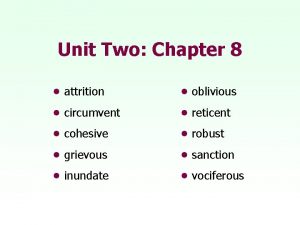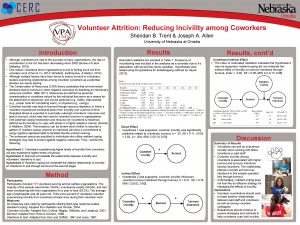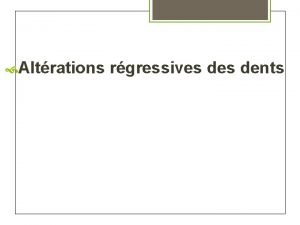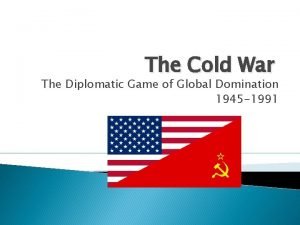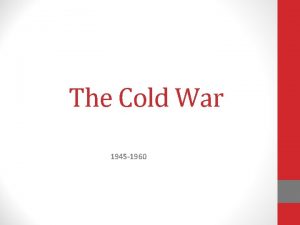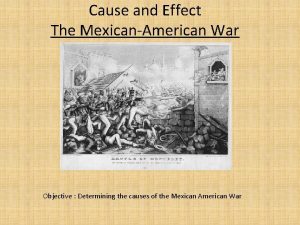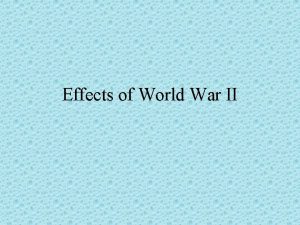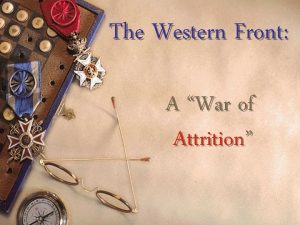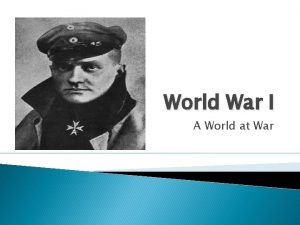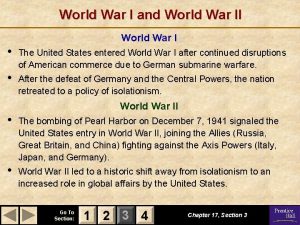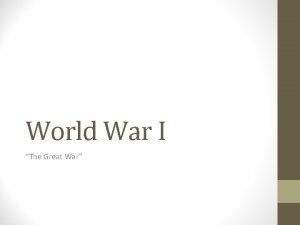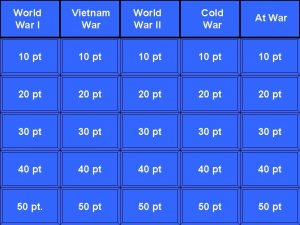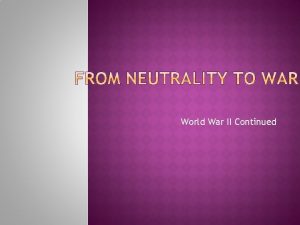World War I War of Attrition The Effects





















- Slides: 21

World War I War of Attrition

The Effects of New Technology w Prior to WWI, the last major European war was in 1870 w Significant changes in weapons had occurred since then – weapons had become far more destructive and effective w Military strategists were slow to adjust their tactics to these new weapons

Machine Gun w Powerful defensive weaopn – made attacking enemy trench virtually impossible w Very rapid fire – 1914: 400 -600 rounds per minute – 1918: over 1000 rounds per minute! w This was a weapon of mass slaughter: 1 machine gun = 80 rifles! w Example: Battle of Somme, 1916 at Beaumont Hamel nearly 800 soldiers of the Newfoundland Regiment were killed in just 20 minutes

Long Range Artillery w Artillery refers to cannon w New advances meant that cannons could now be loaded from the read with massive cartridges w Fire more frequently, longer range and more destructive - High explosive shells w Used as offensive weapon – attack enemy trench – Cut barb-wire & destroy trenches

Railway Gun

Paris Gun: German Could fire a 106 kg shell 130 km

Effect: Trench Warfare & War of Attrition w These weapons were terribly destructive w The effect of these developments was Trench Warfare – trenches were the only place a soldier could take cover w Trench construction took on significant importance as war raged on w Elaborate designs, tunnels and underground bunkers were constructed

Trench Construction

WWI Battle Field

Trenches II

Trenches III

Trench Life w Trench life was horrific – a soldier was always wet, hungry, and in danger of being killed at any moment w Shell shock – Post Traumatic Stress Disorder – was not yet a recognized mental illness w No-mans land – the battlefield between enemy trenches, was littered with the dead and dying w Rats and disease were widespread

Life in the trenches

War of Attrition w Basic strategy – bomb enemy trench – send men “Over-The Top” – w Soldiers faced a hail of shrapnel caused by artillery and machine gun fire w Inevitably the attack fizzles out – DO IT AGAIN! w This strategy demanded more men, more ammunition and more supplies w 11 major offensives each lasting months at a time

Going “Over The Top”


Pictures of World War One w Some pictures of trenches and the destruction caused by world war one

People Responsible for World War One w King George V, Czar Nicholas II and Kaiser Wilhelm II

Trenches http: //techcenter. davidson. k 12. nc. us/Grou p 9/trenchwar. htm

Wounded and Nursing in the War w Nurses in the war A soldier wounded by mustard gas some wounds will be permanent

Wounded Soldiers in the War w Nurses taking care of wounded soldiers (top left) and soldiers wounded behind the lines waiting for medical attention (bottom left) w Cargo ship bringing medical suppliess to the war front (bottom right)
 Effects of second world war
Effects of second world war Effects of world war 2
Effects of world war 2 Attrition in ww1
Attrition in ww1 Is attrition a type of transportation
Is attrition a type of transportation Biasnn
Biasnn 3 types of bias
3 types of bias Attrition bias
Attrition bias Early warning attrition tracker model
Early warning attrition tracker model Chapter 8 sentence check 1 answers key attrition
Chapter 8 sentence check 1 answers key attrition Hotel attrition clause example
Hotel attrition clause example Types of attrition
Types of attrition Doctoral initiative on minority attrition and completion
Doctoral initiative on minority attrition and completion Attrition vs retention
Attrition vs retention Attrition prediction model in excel
Attrition prediction model in excel Volunteer attrition
Volunteer attrition Attrition dentaire
Attrition dentaire Attrition bias
Attrition bias Effects of the cold war
Effects of the cold war Cold war cause and effects
Cold war cause and effects Effects of the mexican-american war
Effects of the mexican-american war Cause and effect of mexican american war
Cause and effect of mexican american war Causes and effects of the french and indian war
Causes and effects of the french and indian war








